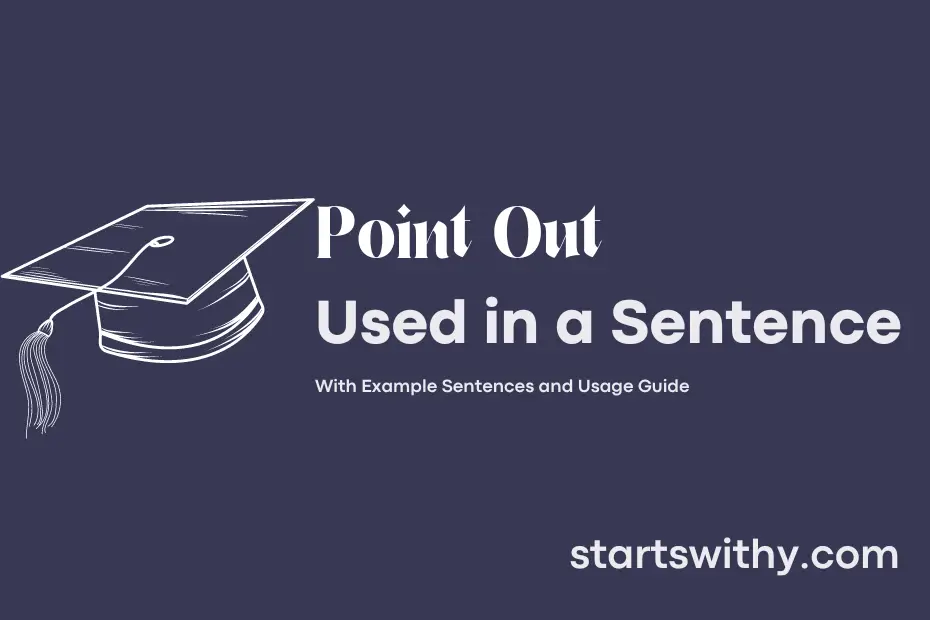Have you ever wanted to draw attention to a specific detail in a sentence or text? When you “point out” something, you are highlighting or indicating a particular piece of information for clarity or emphasis.
This common phrase is often used to direct someone’s attention to a specific element within a larger context. Whether you’re identifying an important fact, correcting a misunderstanding, or simply drawing focus to a noteworthy detail, “pointing out” serves as a useful tool in effective communication.
7 Examples Of Point Out Used In a Sentence For Kids
- Point out the letter “A” in the alphabet.
- Can you point out the color blue in the picture?
- Point out the triangle shape in this drawing.
- Let’s point out all the animals in the picture.
- Point out the sun in the sky.
- Can you point out the red car?
- Let’s all point out our favorite fruit.
14 Sentences with Point Out Examples
- Point out the key points of the lecture for the students who missed the class.
- During group discussions, make sure to point out relevant practical examples to support your arguments.
- Point out any errors or inconsistencies in the research paper before submitting it.
- When studying for exams, it’s helpful to point out the important formulas and concepts to focus on.
- In a debate competition, it’s essential to point out the flaws in your opponent’s arguments.
- Point out the benefits of joining student clubs and organizations on campus.
- When giving a presentation, remember to point out the main findings of your research.
- Point out the cultural significance of traditional Indian festivals during a discussion on diversity.
- During a group project, point out the different strengths of each team member for better collaboration.
- Point out the importance of time management skills for balancing academics and extracurricular activities.
- When discussing career options, point out the potential growth opportunities in different industries.
- Point out the relevance of incorporating technology in education for better learning outcomes.
- In a literature class, point out the recurring themes and motifs in the assigned texts.
- Point out the key points from the previous lecture to provide context for the current topic being discussed.
How To Use Point Out in Sentences?
Point Out is used to draw attention to someone or something in a conversation. It is often used to highlight a specific detail or aspect that may have been overlooked or unnoticed.
Here’s how to use Point Out in a sentence:
- Direct Attention: “I wanted to point out that the meeting has been rescheduled to next Monday.”
- Highlight: “She was quick to point out the errors in the report.”
- Emphasize: “The teacher pointed out the importance of completing the assignment on time.”
- Clarify: “Let me point out that we need to follow the new procedure for project submissions.”
- Correct: “He pointed out that the statement made by the colleague was incorrect.”
Remember to use Point Out when you want to emphasize, clarify, highlight, or correct something in a conversation. It adds emphasis and helps ensure that the specific detail you are mentioning is noticed and understood by others.
Practice using Point Out in your daily conversations to become more comfortable with incorporating it into your language.
Conclusion
In this article, various sentences with the phrase “point out” have been used to highlight the importance of drawing attention to specific information or details. When we point out something, we are directing focus or bringing clarity to a specific point or issue. By using this phrase effectively, one can help others understand key concepts, clarify misunderstandings, or emphasize significant aspects of a conversation or discussion.
Whether pointing out errors, providing guidance, or indicating noteworthy factors, using the phrase “point out” can be a useful communication tool in effectively conveying messages. By incorporating this phrase in conversations, written communications, or presentations, individuals can ensure that essential information is brought to light and properly understood by others, thus improving overall clarity and comprehension.



